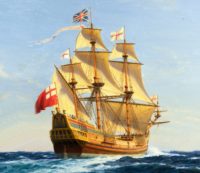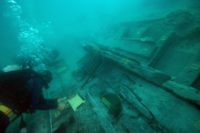Preserving stores of food and drink on a ship during the long and treacherous ocean voyages of the 16th and 17th century was such a challenge that we still think of scurvy, rotten meat and brandy rations in place of water when we think of the sailor’s life before refrigeration. Actual scientific data on how well shipboard supplies lasted, however, is virtually non-existent. Texas A&M University nautical archaeologist Grace Tsai has crafted an experiment to find out what really happened to the unrefrigerated supplies during transatlantic voyages.
 Her departure point was the archaeological remains of three shipwrecks, primarily that of the Warwick which sank in Bermuda’s Castle Harbor in 1619 when a hurricane dashed it against the reefs at the base of a limestone cliff where her captain had anchored her in the hope the cliff face would provide some protection from the high winds. The merchant vessel’s next destination was the English colony of Jamestown which was in dire need of supplies. The Warwick‘s provisions and the fortuitous way it collapsed on its starboard side in deep silt, preserving that half of the wreck from the depredations of woodworm, make it an important source of information about life on board a 17th century ship.
Her departure point was the archaeological remains of three shipwrecks, primarily that of the Warwick which sank in Bermuda’s Castle Harbor in 1619 when a hurricane dashed it against the reefs at the base of a limestone cliff where her captain had anchored her in the hope the cliff face would provide some protection from the high winds. The merchant vessel’s next destination was the English colony of Jamestown which was in dire need of supplies. The Warwick‘s provisions and the fortuitous way it collapsed on its starboard side in deep silt, preserving that half of the wreck from the depredations of woodworm, make it an important source of information about life on board a 17th century ship.
The wreck was extensively excavated and documented between 2008 and 2012 by a team including maritime archaeologists and experts from the Institute of Nautical Archaeology and the Center of Maritime Archaeology and Conservation at Texas A&M. Grace Tsai began studying the data on the food supplies recovered from the Warwick just as the exploration was coming to a close in 2012. Her focus was analysis of sailors’ diets based on modern nutritional guidelines. She looked at the type of food they ate and how they prepared it based on period recipes, but the question of preservation is a large variable when trying to determine the nutrient value of a food.
 So Tsai’s team got a bunch of period-accurate supplies and stored them inside the tall ship Elissa built in 1877 and now a museum docked in Galveston, Texas. From August through October 2017, the about the amount of time a transatlantic voyage would take in the 16th and 17th centuries. To ensure the experiment was as probative as possible, Tsai and her colleagues got hardcore about recreating the proper foodstuffs. They packed salted meat, peas, oats, those ship’s biscuits you see in museums that are basically rocks, heirloom rice, beer, wine and one barrel of fresh spring water. The team even made the salted meats from scratch, using the butcher marks on beef bones found on the Warwick wreck to determine how provisioners sized the cuts for optimal preservation. The salt itself they imported from Guérande in Brittany, France, whose salt marshes have been producing highly prized and widely traded salt for a thousand years.
So Tsai’s team got a bunch of period-accurate supplies and stored them inside the tall ship Elissa built in 1877 and now a museum docked in Galveston, Texas. From August through October 2017, the about the amount of time a transatlantic voyage would take in the 16th and 17th centuries. To ensure the experiment was as probative as possible, Tsai and her colleagues got hardcore about recreating the proper foodstuffs. They packed salted meat, peas, oats, those ship’s biscuits you see in museums that are basically rocks, heirloom rice, beer, wine and one barrel of fresh spring water. The team even made the salted meats from scratch, using the butcher marks on beef bones found on the Warwick wreck to determine how provisioners sized the cuts for optimal preservation. The salt itself they imported from Guérande in Brittany, France, whose salt marshes have been producing highly prized and widely traded salt for a thousand years.
After their stint in the Elissa’s hold, many of the provisions still seem edible. For safety reasons, nobody will actually be tasting the experimental results, but the baked ship biscuits are in the best shape by far, a testament to their legendary hardiness. The salted beef, however, has taken on a pinkish center resembling prosciutto. It has a pungent smell, says Tsai, though it isn’t rotten.
A big exception is the natural spring water, which has turned cloudy with greenish bits and “smelled pretty disgusting,” Tsai says. Sailors may have preferred quenching their thirst with beer and wine, which remained more palatable. Still, a surprising amount of lingering yeast fermentation and carbonation caused the beer barrel to leak and grow mold.
Yet the biggest surprise came from the diversity of microbes found in some of the food. Early genomic sequencing analyses, mostly from the salted beef, suggest that many of the bacteria are neither illness-causing pathogens nor beneficial probiotics—most seem to be relatively neutral. The unexpected microbial bounty, however, has forced the researchers to expand their genomic sequencing efforts.
I wonder if any wild yeast strains made it into that beer. The beer was made according to a historical recipe — people will be able to get a taste of it (the fresh version, not the moldy stuff) at a fundraiser on the Elissa later this month — but I don’t know if they secured a period-accurate yeast strain from before the discovery of a pure yeast culture by Carlsberg’s Emil Hansen in 1883. It seems to me that would be a significant factor in preservation given how wild yeast could sicken a barrel of beer even when it didn’t spend two months in a ship’s hold.
Here’s a video of the timber remains of the wreck of the Warwick, filmed in 2011. It’s a long, peaceful exploration of the site without commentary or soundtrack. Someone needs to loop it for one of those sleeping sounds apps.